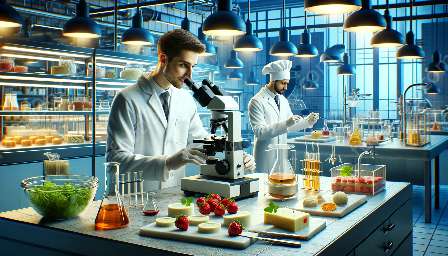Microbial growth and control in food is a fascinating and crucial aspect of food science that encompasses the disciplines of food microbiology and culinology. Understanding the intricate relationship between these fields is imperative for ensuring food safety and maintaining high-quality food products.
Understanding Microbial Growth in Food
Microbial growth refers to the proliferation of microorganisms such as bacteria, yeast, and mold in food. These microorganisms can significantly impact the safety and quality of food products. Factors that influence microbial growth in food include temperature, pH, available nutrients, and water activity.
Temperature plays a crucial role in microbial proliferation, as most microorganisms have an optimum temperature range for growth. The pH of food also affects microbial growth, as different microorganisms thrive in varying pH levels. Available nutrients in food provide essential resources for microbial growth, making it crucial for food producers to understand and control these factors. Water activity, which is the measure of water availability for microbial growth, is another critical factor affecting microbial proliferation.
Impact of Microbial Growth on Food
When microorganisms proliferate in food, they can lead to various undesirable outcomes, including food spoilage and foodborne illnesses. For example, the growth of certain bacteria, such as Salmonella and Escherichia coli, can result in foodborne illnesses that pose significant health risks to consumers. Additionally, the presence of mold in food can lead to spoilage, altering the taste, texture, and overall quality of the product.
Role of Food Microbiology
Food microbiology plays a pivotal role in understanding and mitigating the impact of microbial growth in food. This discipline involves the study of microorganisms in food and their effects on food safety, preservation, and quality. Food microbiologists employ various techniques to identify, characterize, and control microorganisms present in food.
One such technique is microbial testing, which involves analyzing food samples for the presence of harmful microorganisms. Through advanced methods such as polymerase chain reaction (PCR) and next-generation sequencing, food microbiologists can accurately detect and identify microorganisms, allowing for targeted control measures to be implemented.
Furthermore, food microbiologists contribute to the development of preservation methods that inhibit microbial growth and extend the shelf life of food products. Techniques such as pasteurization, sterilization, and the use of preservatives are employed to prevent microbial spoilage and ensure food safety.
Integration with Culinology
Culinology, which represents the blending of culinary arts and food science, is integral to the effective management of microbial growth in food. Culinologists collaborate with food microbiologists to develop innovative food products while ensuring microbiological safety and quality.
By understanding the principles of food microbiology, culinologists can creatively formulate recipes and food processes that minimize the risk of microbial proliferation. For instance, optimizing cooking temperatures and times, as well as implementing proper sanitation practices in food preparation environments, are essential considerations inculcated by the integration of food microbiology within the realm of culinology.
Control Measures for Microbial Growth
Controlling microbial growth in food is imperative for ensuring food safety and quality. Several control measures are employed to mitigate the risk of microbial proliferation and its associated consequences:
- Temperature Control: Maintaining proper temperatures during food storage, processing, and preparation is essential for inhibiting microbial growth.
- pH Management: Adjusting the pH of food products to levels that are unfavorable for microbial growth can effectively control the proliferation of certain microorganisms.
- Hygiene Practices: Implementing stringent hygiene practices in food processing environments and kitchens is crucial for preventing microbial contamination and ensuring food safety.
- Preservation Techniques: Utilizing preservation methods such as canning, refrigeration, and packaging to limit microbial proliferation and extend the shelf life of food products.
Advancements in Food Microbiology and Culinology
The field of food microbiology and culinology is continuously evolving, driven by advancements in technology, scientific research, and consumer demands. Emerging technologies, such as advanced microbial detection systems and precision processing equipment, are revolutionizing the control of microbial growth in food.
Furthermore, consumer awareness and preferences regarding food safety and quality are influencing the development of new approaches to minimize microbial risks in food products. This includes the integration of natural preservatives, the use of probiotics for enhanced food safety, and the application of novel processing techniques that preserve nutritional value while inhibiting microbial proliferation.
The synergy between food microbiology and culinology is paving the way for the creation of innovative, safe, and high-quality food products that meet the demands of today’s consumers.


